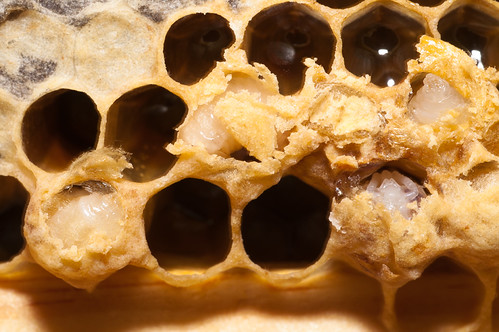In my previous post, I mentioned that I removed 8 frames of honey from the hive over the weekend. One them had a line of drone cells on the very bottom of the frame.
Here is a closer shot.
I took a small spoon to remove the drones and wax before starting the harvest, and I was horrified to see varroa mites scurry out of the cells as I scooped them out. I’ve checked the hive regularly for mites over the past year, and this is the first time I’ve ever seen them. They do prefer drone cells, and the hive has been producing a bunch being spring time and all.
Here is a shot after removing the comb.
Here’s a closeup of the nasty little bugger.
I’ll need to be more vigilant in my inspections over the next few weeks, and I’ll put a sticky mat on my bottom board next week to do a mite drop count. This does give me pause about sharing some brood frames when I install my package next week because I’d hate to introduce mites into the new hive right off the bat.
Any suggestions on non-chemical mite control? Do those drone frames actually work?








How about a powdered sugar shake?
I’ve recently done a shook-swarm to shake all my bees out onto completely new foundation and burn up the old frames. It may sound harsh, and it does mean they lose all their brood, but as long as it’s a strong colony they get going again quickly and you destroy a high percentage of the mites. I’ve heard it said that around 80% of them are in the brood once winter’s over. But I’m in the UK and it was early spring at the time – beekeeping in Texas must have very different timings.
Oh, no, Karl! Sorry to hear that! I am not very experienced but it doesn’t sound like they are that bad if you haven’t seen them much before and they were around the drone cells. I am learning so much from your experience, so glad you are writing! I am starting my own bee blog and I will let you know when I get it going. My packages arrive in May.
– Lorie
Awesome photos of those lil nasties, Karl!
After a couple years of fighting varroa, we’ve decided to let the colonies evolve mite resistance on their own. In other words, the hives that survive without our intervention against mites are those we want to encourage and split. Otherwise, we’ll end up with dependent hives that haven’t evolved to win the varroa battle.
Tough love? Encouraging of survivor bee genetics? Only time will tell 😉
I’m kind of starting to lean that way mainly because it is kind of hard to believe they just picked these up in the past few months. Plus, the whole reason I bought bees from Bee Weaver is their practice of not treating for mites to build up a natural resistance. I’ll play it by ear and see what happens.
Hey there, love the blog! I’m big into urban farming/gardening and have given strong thought to having some urban bees. Seems very rewarding in many ways. Looking forward to reading more from your blog…
I was just reading an experimental treatment from a few years back that involved food grade mineral oil. Turns out FGMO is naturally anti-mite and yet will not harm the bees nor affect the honey. The gist was he used pipe cleaners soaked in FGMO which he fixed to the tops of the frames. The bees walk on it, and when they groom the oil will make the mites drop off.
In their scientific study, all untreated hives succumbed. Two treated hives absconded and the rest dropped from 50% infestation to 4%.
Interesting. Sounds similar to the powdered sugar method of getting rid of mites.